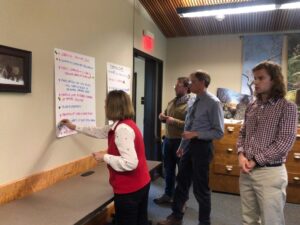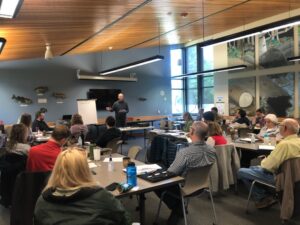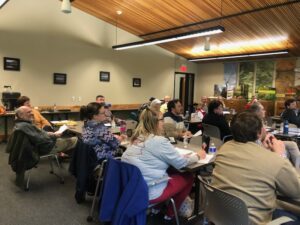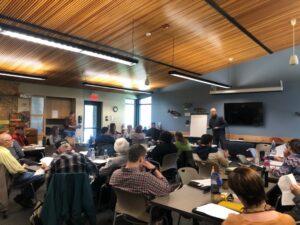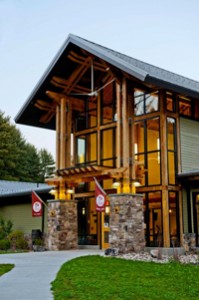PA Wilds Planning Team sets the stage for its future work
The regional effort to grow the outdoor economy in the rural Pennsylvania Wilds turns 20 next year, and in step with that major milestone, the PA Wilds Planning Team met recently to revisit its history and collaborate on where its planning efforts need to go next.
The Planning Team was formed through a groundbreaking intergovernmental cooperative agreement back in 2006 to help spearhead regional planning initiatives related to the regional PA Wilds strategy, then only a few years old. The Planning Team completes its own projects and plans, and its work helps inform the work of the PA Wilds Center for Entrepreneurship, the regional nonprofit that now leads the PA Wilds effort in coordination with federal, state and local partners from the public, private and philanthropic sectors.
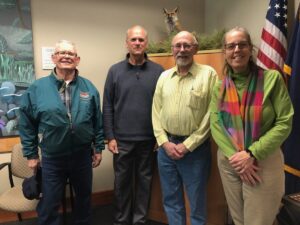
Some of the original founding PA Wilds Planning Team members. Left to right: Jerry Walls, Denny Puko, Dan Glotz and Meredith Hill
The Planning Team held its retreat at Sinnemahoning State Park. Ta Enos, the founder and CEO of the PA Wilds Center for Entrepreneurship, gave a presentation about how the Planning Team helped give rise to the Center. It advanced the idea, early on, that it was important to focus resources on growing rooted local wealth through entrepreneurship as part of the initiative to grow the region’s outdoor economy. That led to a white paper that made its way to DCED, and to the creation of the PA WIlds Small Business Ombudsman position, the precursor to the PA Wilds Center. The Center is now the fiscal and administrative home for the Planning Team, but the Team continues to operate independently, guided by its own by-laws.
“The Planning Team is our largest and longest-standing stakeholder group around this regional effort, and it has helped advance key concepts, like the focus on entrepreneurship and the PA Wilds Design Guide for Community Character Stewardship, that are now critical underpinnings of the work and part of the reason it has been embraced by so many rural communities and become a national model,” Enos says.
Katie de Silva, the Clinton County Planning Director who also serves as the vice chair of the Planning Team, summed up the goals of gathering the team together: “Refresh, recalibrate, and get to know the newcomers.”
There were some new faces on the team, including Frank Grumbine, the Community Preservation Coordinator for the Pennsylvania State Historic Preservation Office.
“It was my very first meeting, and I intend on being an ongoing participant,” said Grumbine. “My role in the planning committee is to emphasize the use of historic preservation as a primary tool for economic development, heritage tourism, and community character in the PA Wilds.”
Joshua Zucal, the Cameron County Director of Marketing, was another newcomer on the team. “Bringing planners and organizations together creates a positive effort for a local voice and opportunity to walk forward together,” he said.
Tracy Gerber, Elk County Planning Director, recently stepped into the role of Planning Team treasurer. “My goal was to learn about the history of the PA Wilds and what their goals are moving forward. Being new to the team, I feel like I have a lot to learn. The event was very informative for me.”
Although the participants come from many different organizations (primarily planning, conservation and economic development organizations), they all have something in common: the belief that our region is a special place and that planning can proactively help sustain the region’s long-term goals. While the PA Wilds Planning Team wants tourism and economic development to blossom in our area, it can’t come at the expense of our beautiful natural wilderness and our unique communities.
In addition to getting to know each other better, the Planning Team members brainstormed and chose the top five goals for the year. They include plans for more cohesive outreach and communications, completing the annual planning study, achieving a better onboarding process for new members and elected officials, strategizing project priorities, and maintaining conservation of scenic viewsheds and working forests.
De Silva said, “Planning is what we are all about, it is our forte, and I think over the pandemic we had lost that focus.” She says these kinds of targeted goals make the team more effective. “We’re creating a solid, attainable project list. We do great work when we have clear assignments and roles. The project list will make that happen naturally.”
With those goals in clear sight, the Planning Team assigned themselves roles for breaking each goal into smaller parts. Meetings have been scheduled to focus on specific tasks, such as doing outreach to county commissioners and other government officials.
“The Planning Team was born from the ground up and has always had a collaborative, consensus-building spirit about it,” Enos says. “This is generational work we are all involved in, and the Center is excited to see where the Team goes next with its new planning study. Whatever the focus, their work will continue to inform our nonprofit’s programs and services for communities. We greatly appreciate that our county commissioners continue to support the Planning Team’s work through the participation of their county planners, and that so many other tourism, heritage, conservation and economic development partners are at the table with us.”
If you’d like to learn more about the PA Wilds Planning Team, click here.

